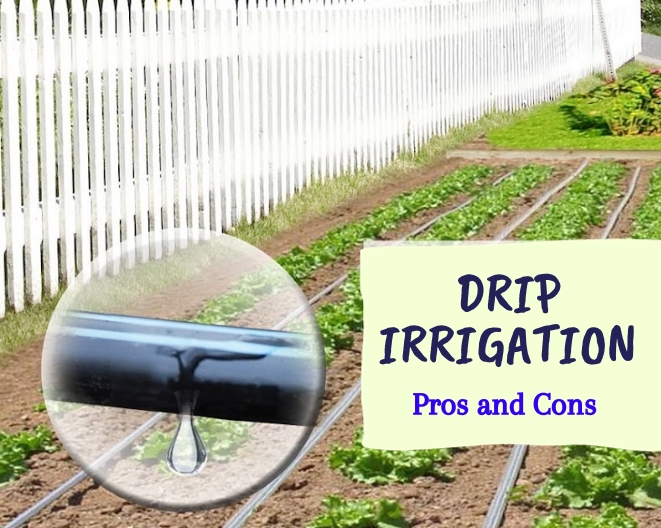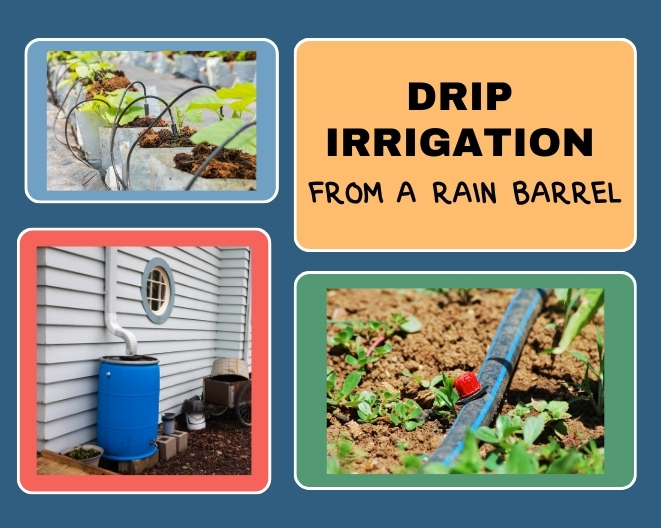Drip irrigation, often touted as a modern marvel in agricultural practices, has gained significant attention in recent years. As with any innovative technique, it’s essential to delve deep into its merits and drawbacks. This comprehensive analysis aims to provide insights into the “Drip Irrigation Pros and Cons,” shedding light on its efficacy, challenges, and overall worth.
Understanding Drip Irrigation
Drip irrigation is an irrigation method that saves water and fertilizer by allowing water to drip slowly to the roots of plants, either onto the soil surface or directly onto the root zone. This method ensures that plants receive a consistent supply of moisture and nutrients, promoting healthier growth and potentially higher yields. To comprehend its significance fully, it’s essential to explore the intricacies of drip irrigation, its mechanisms, and its applications.
Mechanism of Drip Irrigation
At its core, drip irrigation operates on a simple yet effective principle: delivering water directly to the plant’s root system. Through a network of pipes, tubes, and emitters, water is distributed in controlled amounts, ensuring minimal wastage. This precision ensures that plants receive the necessary moisture without saturating the surrounding soil, leading to optimal growth conditions.
Components of a Drip System
- Emitters: These are devices responsible for releasing water. Available in various flow rates, emitters determine the volume of water delivered to each plant.
- Tubing: Serving as the conduit for water, tubing connects the water source to the emitters. Its design minimizes pressure loss, ensuring efficient water distribution.
- Filters: Essential for maintaining system longevity, filters prevent debris, sediment, and other contaminants from clogging emitters and tubing.
- Controllers: Modern drip systems often incorporate controllers or timers, allowing users to automate watering schedules, and optimize water usage.
Drip Tape Irrigation and its Merits
Drip tape irrigation is a subset of drip irrigation that utilizes flat tape instead of cylindrical tubing. This design offers:
- Cost-Effectiveness: Drip tape systems are often more affordable than traditional drip setups, making them accessible to a broader range of farmers.
- Uniformity: The design of drip tape ensures even water distribution, contributing to consistent crop growth and health.
Drip Irrigation for Trees: A Specialized Approach
When considering “drip irrigation for trees,” it’s vital to recognize its tailored application:
- Deep Root Watering: Drip systems can be customized to deliver water deeper into the soil, reaching tree roots effectively.
- Tree Health: Properly implemented drip systems can promote tree health, reduce stress, and mitigate environmental challenges like drought.
Optimizing Drip Irrigation for Shrubs
Determining how long to run drip irrigation for shrubs is crucial for optimal growth:
- Root Depth: Understanding the root depth of shrubs helps in determining the duration of irrigation sessions.
- Soil Type: Different soil types retain water differently. Sandy soils may require more frequent, shorter irrigation cycles, whereas clay soils might necessitate longer, less frequent sessions.
Drip Irrigation Pros and Cons
Drip irrigation has emerged as a game-changing technique in the realm of agricultural and landscape watering. Its precise, efficient method of delivering water directly to plant roots has garnered attention and acclaim. However, like all systems, drip irrigation comes with its own set of advantages and challenges. Let’s delve deeper into the “Drip Irrigation Pros and Cons” to provide a comprehensive understanding.
Pros of Drip Irrigation
Drip irrigation stands out as a revolutionary approach to watering plants, particularly in agriculture, horticulture, and landscaping. The system’s design offers several advantages that have made it increasingly popular among farmers, gardeners, and environmental enthusiasts. Let’s explore the significant benefits associated with drip irrigation:
1. Water Conservation:
At the forefront of its advantages is water conservation. Unlike traditional irrigation methods that broadcast water over large areas, drip irrigation delivers water directly to the plant’s root zone. This targeted approach significantly reduces water wastage through evaporation or runoff, ensuring plants receive the exact amount they need.
2. Enhanced Plant Health:
By supplying water precisely where plants need it, drip irrigation promotes healthier root systems. Consistent moisture levels in the root zone encourage robust growth, increased yield for crops, and improved vitality for ornamental plants.
3. Weed Suppression:
Traditional sprinkler systems can inadvertently water non-plant areas, fostering weed growth. Drip irrigation’s focused application limits moisture outside of the plant root zone, effectively reducing weed germination and growth.
4. Reduced Disease Spread:
Overhead watering methods can splash soil onto plant foliage, potentially spreading soil-borne diseases. Drip irrigation minimizes this risk by delivering water directly to the soil, thereby reducing foliage wetness and disease transmission.
5. Fertilizer Efficiency:
Beyond water, drip systems excel in nutrient management. They allow for precise delivery of fertilizers or nutrient solutions directly to plant roots. This targeted approach ensures optimal nutrient absorption, minimizing waste and potential environmental runoff.
6. Soil Erosion Prevention:
The controlled, slow application of water in drip irrigation minimizes soil disturbance, helping to maintain soil structure and prevent erosion. This benefit is especially crucial in sloped areas where traditional irrigation might lead to runoff and soil loss.
7. Versatility:
Drip irrigation systems are versatile and adaptable. They can be customized to cater to various plant types, soil conditions, and watering needs. Whether you’re irrigating a vast agricultural field, a garden bed, or individual potted plants, drip systems can be tailored for optimal performance.
In summary, the pros of drip irrigation underscore its efficiency, precision, and environmental benefits. As water scarcity becomes an increasing concern globally, the adoption of drip irrigation offers a sustainable solution, balancing agricultural productivity with responsible water management.
Cons of Drip Irrigation
While drip irrigation offers a multitude of benefits, it’s essential to recognize that like any system, it comes with its set of challenges and limitations. Here are some notable cons associated with drip irrigation:
1. Initial Cost:
One of the most significant barriers to adopting drip irrigation for many growers is the initial setup cost. The system requires specialized components such as drip lines, emitters, filters, and control valves. These components, along with the necessary infrastructure like pumps and controllers, can result in higher upfront expenses compared to traditional irrigation methods.
2. Clogging Concerns:
Drip systems are susceptible to clogging due to mineral deposits, algae, or organic matter present in the water supply. Over time, these obstructions can impair emitter performance, leading to uneven water distribution and potential plant stress. Regular maintenance, including filtration and system flushing, is crucial to mitigate this issue.
3. Complexity of Installation and Management:
Designing and installing a drip irrigation system requires careful planning and expertise. Proper spacing, emitter selection, and system layout are critical factors that influence its effectiveness. Additionally, ongoing management, including monitoring for leaks, adjusting flow rates, and ensuring even water distribution, demands consistent attention and expertise.
4. Potential for Overwatering:
Paradoxically, while drip irrigation is lauded for its water efficiency, there’s a risk of overwatering if not appropriately managed. Factors such as incorrect emitter placement, system malfunctions, or programming errors can lead to excessive moisture in the root zone, promoting root diseases and reducing plant vigor.
5. Sensitivity to External Factors:
Drip systems can be sensitive to external factors such as soil type, slope, and weather conditions. In certain soils, particularly heavy clays, water may spread laterally rather than infiltrate deeply, potentially resulting in shallow root development. Moreover, extreme temperatures or wind can influence water distribution patterns, necessitating system adjustments or additional monitoring.
6. Maintenance Requirements:
Beyond the initial installation, drip irrigation systems demand ongoing maintenance to ensure optimal performance. This includes periodic checks for leaks, emitter functionality, and system efficiency. Neglecting regular upkeep can compromise the system’s effectiveness and lead to increased operational costs over time.
Addressing these cons through proper design, installation, and maintenance practices can help maximize the benefits of drip irrigation while mitigating potential drawbacks.
Conclusion
In weighing the pros and cons of drip irrigation, it becomes evident that its value extends beyond mere convenience. It represents a sustainable approach to water management, aligning with global efforts to conserve resources and promote responsible agriculture. As technology continues to advance and practices evolve, the future of drip irrigation looks promising, provided stakeholders remain vigilant in optimizing its benefits and mitigating its challenges.
FAQs
A: A major problem associated with drip irrigation is the potential for clogging. Over time, emitters can become blocked by sediment, algae, or mineral deposits, affecting the system’s efficiency and necessitating regular maintenance.
A: The advantages of irrigation include efficient water use, targeted delivery to plant roots, and reduced water wastage. However, when considering “Drip Irrigation Pros and Cons,” disadvantages encompass issues like system clogging, initial setup costs, and the need for ongoing maintenance.
A: Yes, drip irrigation is generally considered environmentally friendly due to its water-saving capabilities. Delivering water directly to plant roots, minimizes wastage and reduces the overall water footprint of agricultural operations.
A: While drip irrigation offers numerous benefits, some reasons it might not be widely adopted include the initial setup costs, concerns about system maintenance, and the need for proper training and management to ensure optimal performance.
A: One negative effect associated with drip irrigation can be the potential for overwatering if not managed correctly. Additionally, improper system maintenance can lead to clogging or uneven water distribution, affecting plant health and system efficiency.






2 Comments
[…] Drip Irrigation Pros and Cons: Is It Worth the Hype? […]
[…] Must read: Drip Irrigation Pros and Cons: Is It Worth the Hype? […]